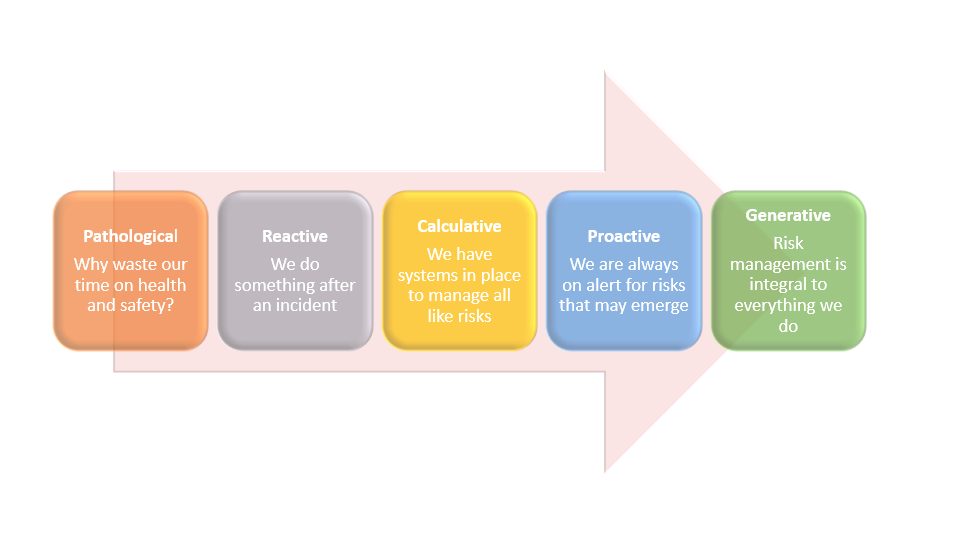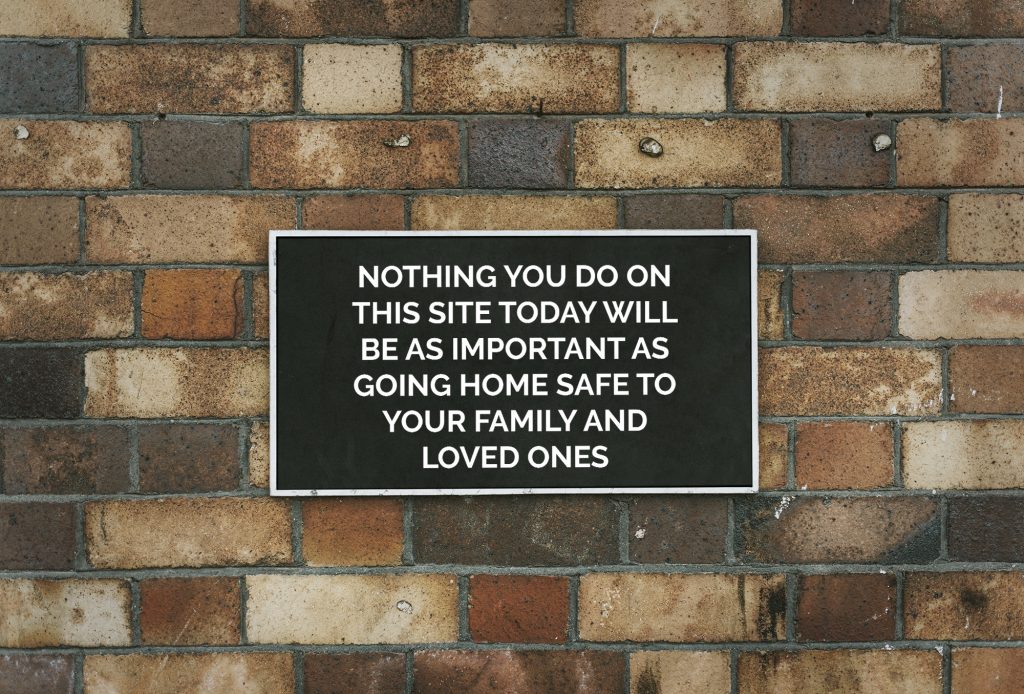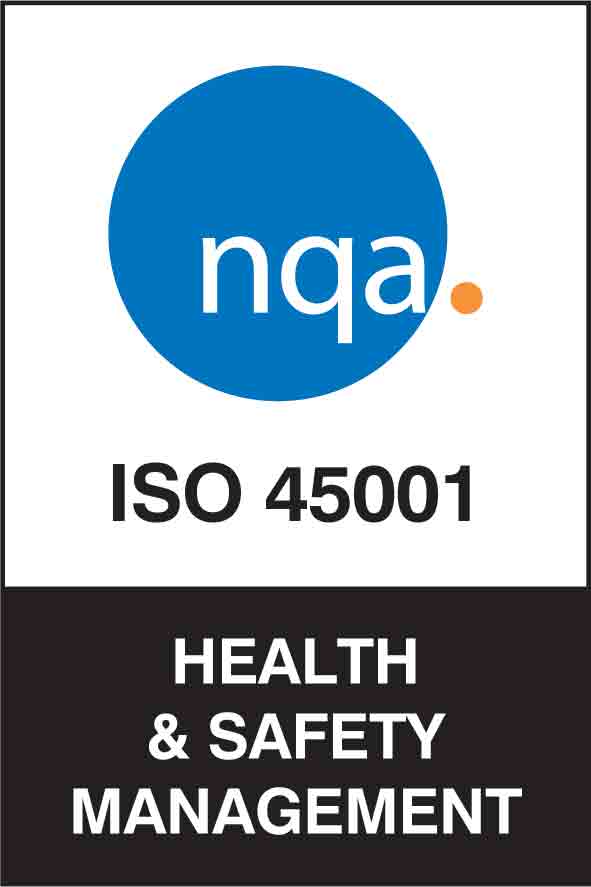BLOG
Promoting a positive workplace health and safety culture, led from the top
When it comes to workplace health and safety, most would agree that physical controls can only go so far. In recent years, the concept of building a positive ‘safety culture’ has gained momentum, particularly in higher-risk industries, as the link between workers’ attitudes and workplace incidents becomes ever clearer.
In fact, it is suggested that 95% of workplace accidents have an element of unsafe behaviour attached to them, and that a poor safety culture can be just as influential on safety outcomes as an organisation’s safety management system.
In this article, we establish what safety culture is, explain why it should be led from the top, and share some examples of good practice.
What do we mean by safety culture?
‘Culture’ can be defined as the way of life, general customs and beliefs or a group of people. By extension, a ‘safety culture’ can be seen as the product of individual and group attitudes, perceptions, values, competencies and patterns of behaviour in respect to workplace health and safety. A safety culture develops from the combined experience of the people within the organisation, whether or not it is planned, and whether or not it is the one the organisation says it wants.
Investigations into high-profile health and safety disasters have shown that a poor safety culture can be a significant factor in incident causation. For example, following the Kings Cross Fire, Judge Fennel declared that “a cultural change in management is required throughout the organisation”. Similarly, in the aftermath of the Piper Alpha disaster, Lord Cullen stated in his report that “it is essential to create a corporate atmosphere or culture in which safety is understood to be, and is accepted as, the number one priority.”
Safety Culture Survey
Created by our team of highly-qualified consultants, our Health & Safety Climate Survey is an online tool designed to uncover employees’ attitudes and perceptions to workplace health and safety and provide you with an objective measure of your health and safety culture
In truth, it is naïve to think of any organisation as having a single, uniform, cohesive culture, and many studies have identified the presence of subcultures within organisations. These are likely to develop where different work groups are faced with different tasks, different levels of risk, and different working conditions.
Consider a Holiday Resort, for example, with multiple departments ranging from maintenance, housekeeping, food and beverage, all carrying out different tasks and exposed to different levels of risk, in a variety of working conditions. It would not be unimaginable there would be subcultures born from this.

Measuring safety culture
A positive safety culture doesn’t happen overnight; instead, organisations progress through different stages of maturity. This can be thought of as a continuum, ranging from organisations that have unsafe cultures where workers are more concerned with not getting caught (‘pathological’ organisations) through to those that set very high standards and attempt to exceed them (‘generative’ organisations). In generative organisations, safety becomes second nature to everyone.
Your organisation will be somewhere on its safety culture journey. In fact, given the presence of subcultures, you may even find yourself in multiple places on the safety maturity scale. When trying to pinpoint your position, rather than look at your organisation as a whole, consider regional, perhaps departmental, differences in culture. It can sometimes be easy to overlook this, as maybe on the whole you are “good”.
Ask yourself where you think your organisation is, then really self-reflect; are you really there? Then ask yourself what your employees, customers and the general public might say.
This maturity model can be used both as an assessment tool and as an improvement tool. If you are interested to know where your organisation currently places on the ‘ladder’, our Safety Culture Survey can provide you with an objective measure of your health and safety culture and serves as a great starting point for any organisation looking to delve deeper into ‘the way things are done’ and bring about positive change.
The impact on organisations
- Increased accidents (due to risk-taking behaviour and shortcuts being taken, leading to production delays, higher rates of absence, poor staff retention and personal injury claims);
- Inflated insurance premiums (if your performance drops, you are a higher ‘risk’ to insure);
- Fines (as less than favourable working conditions may attract regulatory attention due to concerns being raised or due to an accident which leads to an investigation and possible prosecution); and
- Reputational damage and loss of revenue (commercial and domestic buyers are becoming increasingly aware of who they are buying from and how they operate as an organisation or treat their employees).

All of these are bad for business. In fact, while health and safety is often viewed as sitting outside of core business objectives, many organisations have found that improving workplace standards provides financial benefits.
Investments are repaid by, for example, in:
- Enhanced productivity and efficiency;
- Reduced staff absence; and
- Reduced staff turnover.
Contrary to what some might believe, cost-effective investment in health and safety is as valuable as any other investment in your company and tackling the causes of accidental losses should not be viewed as an unnecessary overhead but rather an investment in your business. Indeed, a combination of reducing accident costs and prevention costs can lead to dramatic savings in your company’s bottom line.
This was the key message of IOSH’s Li£e savings campaign, which aimed to demonstrate to organisations that good health and safety management doesn’t just save lives, but money too. It should never be about just ticking a box to say, “I’ve investigated that”, then moving on; really think about the value this can bring.
Again, all of this comes back to the culture of the organisation, as only by getting that right will you see positive results.
The impact on people
Business benefits aside, it’s important to acknowledge the impact that a poor safety culture can have on people, as they are the outcome of your safety culture and leadership.
Everyone should return home at the end of the day in the same condition they left home that morning. Unfortunately, 111 people died last year as a result of their work. It’s important not to lose sight of the fact that a workplace accident can have devastating effects on not only the injured person but their family too.
Crucially, in his 1943 paper “A theory of Human Motivation”, the American psychologist Abraham Maslow identified safety as the second of five basic human needs, just behind the most basic needs of food, water and shelter. Without satisfying this need for safety, we cannot satisfy more complex needs, and cannot reach our potential and achieve self-fulfilment and growth. This is a lesson many managers have taken on board when trying to motivate staff.

The role of leaders
The most successful organisations lead by example, taking a top-down approach to health and safety.
In fact, the HSE points out that although many companies use the term ‘safety culture’ to refer to the inclination of their employees to comply with rules or act safety or unsafely, it is the culture and style of management that is even more significant. For example, managers may:
- Have a natural, unconscious bias for production over safety;
- Tend to focus on the short-term and be highly reactive; and
- Ignore health and safety policies and procedures.
These attitudes and behaviours can filter down to employees and encourage apathy and risk-taking behaviour. It is therefore essential that leaders walk the talk, embody the organisation’s values through their individual behaviour and management practice, and understand the power they have to positively (and negatively) influence health and safety culture
Practical ways to lead from the top
On its website, the HSE talks about the importance of directors and boards leading and promoting health and safety and quotes several health and safety leaders in the public and private sectors. According to one, “Board members who do not show leadership in this area are failing in their duty as directors and their moral duty and are damaging their organisation”.
Indeed, the board should:
- Set the direction for effective health and safety management;
- Establish a health and safety policy that is much more than a document (it should be an integral part of your organisation’s culture, values and performance standards); and
- Take the lead in ensuring the communication of health and safety duties and benefits throughout the organisation.
Examples of good practice include:
- Ensuring health and safety appears regularly on the agenda for board meetings;
- Appointing a board member as the health and safety ‘champion’;
- Appointing a health and safety director to send a strong signal that the issue is being taken seriously and that its strategic importance is understood;
- Setting targets to define what the board is seeking to achieve; and
- Appointing a non-executive director to act as a scrutineer – ensuring the processes to support boards facing significant health and safety risks are robust.
In addition, those responsible for leading your safety culture should possess certain qualities. A good leader:
- Has the motivation to prevent harm to anyone;
- Ensures a safe place of work for staff;
- Has respect for the law and regulations;
- Maintains and develops skills, knowledge and experience in themselves and others;
- Is objective, fair and reasonable;
- Takes responsibility for his own as well as others’ actions;
- Acts with conviction;
- Provides clear direction and communicates effectively; and
- Discharges a duty of care to customers, clients and staff.
3 things you can do now
In addition to ensuring there is a clear plan from the top – covering what you are trying to achieve, how, by when, and with who – there are a number of practical ways to strengthen your safety culture in 2021:
Participation by employees supports risk control by encouraging their ‘ownership’ of health and safety policies. It establishes an understanding that the organisation as a whole, and people working in it, benefit from good health and safety performance. Pooling knowledge and experience through participation, commitment and involvement means that health and safety really becomes ‘everybody’s business’.
Moreover, successful organisations often go further than what is strictly required by law and actively encourage and support consultation in different ways. Consider involving employees at all levels in activities such as:
- Helping to set performance standards;
- Devising operating systems, procedures and instructions for risk control;
- Monitoring and auditing; and
- Participating in ad-hoc problem-solving teams.
The objective of benchmarking is to learn from others, uncover your organisation’s strengths and weaknesses in the process, and then act on the lessons learned – leading to real improvement.
- Benchmark internally and externally within your industry, as this will really challenge your perception of what good looks like.
- If you have past reference points to score against, use those; if you don’t, look externally within your industry. Also consider those subcultures and benchmark against the appropriate industry.
- Consider how your safety performance impacts on your culture, engage with your workforce, and benchmark your result.
Look at the return rate on your staff survey; this is a good indicator of engagement across your business and could be a good place to start.
Safety culture is dynamic – it’s about reflecting on and reacting to experiences, changes in organisations and expectations of both internal and external stakeholders. The last 12 months has emphasised the need to be dynamic in how we manage change, and safety culture is no different.
Finally, above all, remember your people; safety culture is as broad and diverse as your workforce, with different backgrounds, cultures and tolerances. People are unique and, as such, your safety culture approach needs to be too.
Make health and safety everyone's business
If create a positive health and safety culture is a top priority for your organisation this year, our experienced safety specialists can help you to explore different approaches, including a Behavioural Safety Programme, Safety Culture Survey, Mock Trial and more. For more information and to discuss your specific needs, call 0345 226 8393.
Sign up for the latest news & insights
Resources
Latest News & Insights

Do ADHD and autism qualify as a disability? | Understanding the Equality Act 2010 and new case law
BLOG Written on 14 July 2025 When an employee discloses that they have ADHD or autism, many employers find themselves asking: Is this classed as

Privacy vs practicality | Are you entitled to know the reason for an employee’s sickness absence?
BLOG Written on 14 July 2025 When an employee calls in sick, it’s natural for employers to want to understand the situation. However, questions around

Education | What school leaders need to know about September 2025 pay changes
BLOG Written on 9 July 2025 As we near the end of the summer term, headteachers, school business managers and senior Trust staff, along with

Employment Rights Bill Implementation Roadmap | Your quick guide to what’s coming when
BLOG Written on 4 July 2025 The Employment Law Bill promises the biggest shake-up of UK employment law in decades. Having recently cleared the Committee

Fewer lives lost | Key takeaways from the HSE’s 2024/25 fatal injury statistics
Blog Written on 3 July 2025 The Health and Safety Executive (HSE) has published its provisional fatal injury statistics for 2024/25, revealing a welcome decline

Candidate feedback | The secret superpower that can strengthen your recruitment process
BLOG Written by Danielle Fargnoli-Read on 25 June 2025 Let’s be honest – recruitment can be tough. You spend a lot of time writing job

New sentencing guidelines could see fines soar for very large organisations
BLOG Written on 23 June 2025 On 1 June 2025, the Sentencing Council introduced important amendments to its guidelines for health and safety, corporate manslaughter,

Don’t rely on AI | 5 areas where employers should exercise caution
BLOG Written by Amy Waters on 20 June 2025 Artificial Intelligence (AI) tools are transforming the way employers manage their operations, from streamlining recruitment to

Can employers lawfully demote employees?
BLOG When faced with performance or conduct issues, employers may look for alternatives to dismissal – one of which is demotion. This usually means reducing






